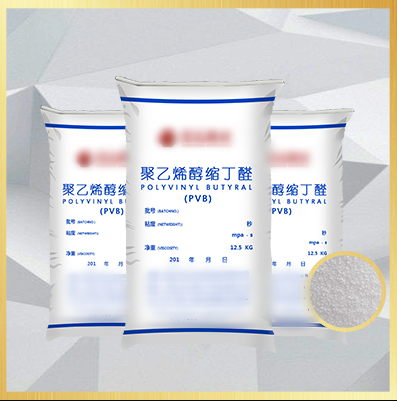Polyvinyl butyral resin (PVB) is a solvent-based resin synthesized by acetalization reaction of polyvinyl alcohol (PVA ) and butyraldehyde under the action of coal catalyst

The appearance of PVB is white spherical porous particles or powder, and its specific gravity is 1:1; but the filling density is only 0.20~0.35g/ml.
The glass transition temperature (Tg) of PVB ranges from 50℃ for low overlap to 90℃ for high overlap; this glass transition temperature can also be adjusted to below 10℃ by adding an appropriate amount of plasticizer.
PVB has excellent film-forming properties and gives the coating film quite good properties such as warp strength, tear strength, abrasion resistance, elasticity, flexibility, gloss, etc.; it is especially used in bonding safety glass interlayers, making the glass have strong impact resistance and penetration resistance, and it is still not replaced by other materials.
PVB coatings have good water resistance, resistance and oil resistance (resistance to aliphatic, mineral, animal and plant oils, but not castor oil). Because PVB contains high hydroxyl groups and has good dispersibility for pigments, it is widely used in printing inks and coatings. In addition, its chemical structure contains both hydrophobic acetal and acetate groups and hydrophilic hydroxyl groups, so PVB has good adhesion to glass, metal, plastic, leather and wood.
Any chemical that can react with secondary alcohols will also react with PVB. In a lot of PVB applications, it's common to mix it with thermosetting resins. This helps to strengthen the hydroxyl groups in PVB, making it more resistant to chemicals, solvents, and water. Depending on the type of thermosetting resin and how much you mix with PVB, you can create coatings with different features like hardness, toughness, and impact resistance.
Pure PVB is non-toxic and harmless to the human body. In addition, ethyl acetate or alcohol can be used as solvents, so PVB is widely used in printing inks for food containers and plastic packaging in Europe and the United States.
As long as PVB is not in direct contact with water, it can be stored for two years without affecting its quality; PVB needs to be stored in a dry and cool place and avoid direct sunlight. Avoid heavy pressure when storing PVB.
PVB dissolves in alcohol, ketones, esters, and some other solvents. The solubility in various solvents varies according to the functional group composition of PVB itself. Please refer to CCP PVB Solvent Solubility Table. Basically, alcohol solvents mix well, but methanol doesn’t blend as easily with substances that have a lot of acetal groups. The more acetal groups there are, the easier it is to mix with ketone and ester solvents. PVB has good solubility in alcohol ether solvents, like Cellosolve. It only partly mixes with aromatic solvents such as xylene and toluene, and it won’t mix at all with hydrocarbon solvents.
PVB (such as Changchun PVB) has good film-forming properties. The coating formed by PVB (Butvar B-72 & PVB WWW-A-20) has excellent properties such as high transparency, elasticity, toughness, strength resistance, oil resistance, flexibility and low-temperature impact resistance.
Website: www.elephchem.com
Whatsapp: (+)86 13851435272
E-mail: admin@elephchem.com